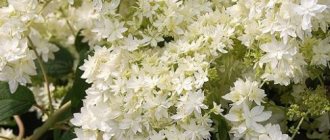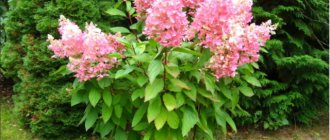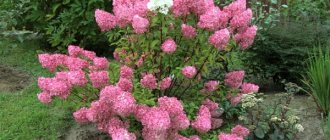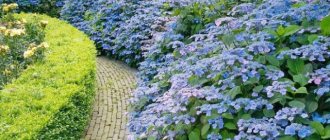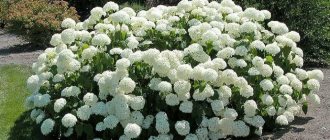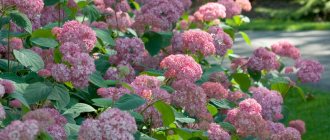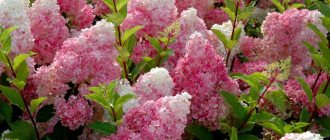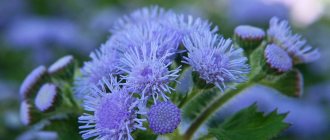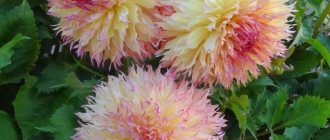Description of hydrangea variety Anabel
The shrub has a dome-shaped shape. The height of the tree hydrangea Anabel is up to 1.5 m, the width of the bush is up to 2-3 m in diameter. The leaves of the plant are oval, up to 20 cm in length, with pointed tips and jagged edges. The leaf blades grow very densely, and the dark green color is retained almost until winter arrives - this is one of the main advantages of the variety.
Anabel is valued for her huge spherical inflorescences
Anabelle is especially appreciated for its beautiful flowering. In mid-summer, in July, it produces small flowers collected in large spherical inflorescences up to 25 cm in diameter. At the beginning of flowering, the inflorescence balls are light green in color, but then they acquire a bright white color and remain that way until autumn.
Important! There is also a subspecies of the Anabel Pink hydrangea variety. The bushes are almost identical to each other, and the only difference is the shade of the flowers - Anabel Pink's are pink.
Anabel Pink is a variety of the variety, but not with white, but with pink flowers
The spherical hydrangea Anabel can become a long-liver in the garden; its life cycle lasts about 45 years. The plant develops quite quickly, annual growth can be up to 20 cm.
Origin and description of appearance
China and Japan are considered the birthplace of the perennial. The height of the plant reaches 110 cm, and its diameter can exceed 3 m. A large number of shoots cannot form on thin branches and stems. The bark is colored brownish-gray. The decorative crop is developing rapidly, so it is important to trim the bush in a timely manner in order to form it.
Garden hydrangea Anabel
The large, slightly elongated foliage of the ornamental crop is painted in a dark green palette. The length of the leaves reaches 20 cm. With the help of petioles, the green mass is attached to the branches of the bush. Thanks to the large number of leaves, the bush looks very rich.
You can admire the gorgeous blooms from June to the first days of October. The diameter of each flower barely reaches 10-15 mm. Each flower with a group of others is collected in a spherical inflorescence. The diameter of the inflorescences exceeds 22-24 cm. The flowers of Annabelle tree hydrangea are painted white.
Note! Using spraying with special coloring agents, you can give the inflorescences of the shrub the desired palette. Very often, a small number of flowers are painted pink.
The variety, according to information from the characteristics, is able to withstand severe Siberian frosts. The most important advantage of the Anabel hydrangea is its longevity. The plant is ready to delight with its flowering for more than 30 years. With the help of a spectacular shrub you can decorate not only your own plot, but also public places. Often bushes are planted to create a living border.
Hydrangea tree Annabelle in landscape design
Gardeners love Annabelle because this shrub looks attractive in almost any landscape. A low, but very spreading and dense plant is used:
- for creating single compositions;
- as an element of group plantings;
- in the form of an unusual hedge;
- for decorating empty corners of the garden, for example, areas near walls and fences.
Hydrangea Anabel blooms until late autumn and produces beautiful and bright white flowers. She continues to decorate the garden when all other plants have already finished flowering and even fly away before the approaching winter. Hydrangea looks attractive against the background of coniferous plants; large white inflorescences emphasize the rich, deep green of conifers.
The plant can completely transform the garden landscape
Landing
The ideal time to plant a hydrangea bush is spring.
You can also carry out this procedure in the fall, but you need to leave time for the plant to adapt and take root before the arrival of winter frosts. It is better to choose a place for planting in advance, since the bush does not like transplants.
An open area under the scorching sun is not the best place for planting; delicate inflorescences can be seriously damaged. A shaded place with no sun will also have a negative impact. The most successful area will be with light shading. Gentle lighting is just what you need for lush hydrangea blooms in the garden.
Since the bush loves water, it is better to plant it away from other large plants that can take up moisture.
Landing algorithm:
- The roots should first be disinfected by soaking them for some time in a weak pink solution of potassium permanganate.
- A pit is prepared for planting measuring 40 x 40 and 50 centimeters deep.
- If the land is not fertile, then prepare a soil mixture of peat, humus and river sand in equal parts
- The roots are evenly distributed and covered with soil, leaving the root collar on the surface. After this, lightly compact the soil around the bush.
- Carry out abundant watering, and then mulch the tree trunk circle to prevent the soil from drying out.
- If it is necessary to plant several bushes, then maintain a distance of one and a half to two meters between them, taking into account the future growth of the bushes.
- Under no circumstances should you fertilize the soil for hydrangeas with ash and lime. This will lead to an alkaline reaction, which the plant cannot tolerate!
Planting and caring for Annabelle tree hydrangea
The hardy shrub does not have too strict care requirements. But it is necessary to become familiar with the rules for growing the variety in order to provide Anabel with comfortable conditions.
For the plant you need to choose a sunny but slightly shaded place
Selection and preparation of a landing site
It is best to plant tree-like Anabelle in the spring, so that the plant is guaranteed to have time to adapt to the site before the onset of winter cold. The place for hydrangea is chosen to be sunny, but with light shading - Anabel loves light, but does not tolerate the scorching sun. You can plant shrubs under the cover of a house wall or next to tall trees. But at the same time, it is important to ensure that they do not take away moisture from the hydrangea, otherwise the plant will always lack nutrients.
In the selected area for hydrangea, dig a planting hole - about 50 cm deep and 40 cm wide. Anabel prefers fertile soils, so humus and peat are added to the extracted soil in equal parts. You also need to add sand to the soil mixture; it will make the soil looser and provide good drainage.
Hydrangea loves moisture, but swampy soil is harmful to it. Therefore, when planting, you need to ensure that drainage water passes deep enough, no closer than 1.5 m to the soil surface.
The shrub loves moisture, but the soil should not be swampy
How to plant hydrangea Anabel
Immediately before planting, the seedling is briefly immersed in water with a solution of potassium permanganate added to it. This will saturate the roots with moisture and at the same time disinfect them.
The landing algorithm looks like this:
- the planting hole is filled halfway with prepared nutrient soil, forming a small mound;
- the Anabel seedling is lowered into the prepared hole and the roots of the plant are straightened so that they lie neatly on the sides of the earthen mound;
- the remaining soil is poured into the hole, filling it entirely to the surface of the ground - the root collar of Anabel should rise slightly above the ground;
- The soil is lightly compacted so that it does not sag, and the young plant is watered abundantly.
Immediately after this, the tree trunk circle is mulched with a dense layer, otherwise the moisture will evaporate too quickly.
Typically, several bushes are planted on a site to form a decorative composition. The distance between individual plants should be at least 2 m; the gardener needs to remember that the bush grows greatly in width.
Advice! When preparing the planting hole and during planting, you should not add lime or wood ash to the ground; they alkalize the soil, which is very harmful to the plant.
The plant can be planted either in groups or alone
Watering and fertilizing
Tree hydrangea Annabelle loves moisture, but despite this, it is a drought-resistant plant. In the hot summer, it can patiently wait for watering without falling off or dying from lack of moisture. Still, it is recommended to water the shrub regularly, in which case the hydrangea will always be green and beautiful.
Watering is carried out in accordance with weather conditions. With the onset of spring and after the snow melts, you need to ensure that the soil in the tree trunk does not dry out. It is recommended to keep the soil slightly moist for Anabelle, and you need to especially carefully control the amount of moisture during flowering. During this period, the plant needs maximum nutrition and nutrients.
It is recommended to water young plants more often during the period of active development. Hydrangea grows shoots and green mass, and sufficient water stimulates it to grow well.
As for fertilizing, they are not strictly necessary. But if you want to grow a truly spreading and abundant flowering plant in the garden, then you should fertilize Anabel several times a season.
Feeding schedule:
- The first feeding is traditionally carried out in early spring, even before the start of the growing season. Complex minerals - phosphorus, potassium, nitrogen - are added to the soil. The last element is especially important in spring for hydrangeas, as it stimulates the growth of shoots and leaves.
- The second time the bush is fed just before the buds open. During this period, it is necessary to add phosphorus and potassium to the soil; they will increase the plant’s endurance and ensure long and beautiful flowering.
- In the summer, Anabel needs to be fed once a month; you can use nitrophoska, diluted manure or chicken droppings, as well as complex minerals. Fertilizers will help prolong flowering and preserve the beauty of the plant until autumn.
Fertilizers provide the plant with more abundant flowering
In addition, in the summer it is recommended to treat Anabel with a solution of potassium permanganate; the product will prevent the bush from becoming infected with fungal diseases.
Hydrangea is also fertilized in the fall. During this period, it is best to fertilize the bush with potassium and phosphorus, as well as organic matter - peat and humus. But nitrogen can no longer be added in the fall; it stimulates growth processes, which the plant does not need at all before wintering.
How to Prune Annabelle Hydrangea
In landscape design, it is customary to trim hydrangea regularly; without pruning, Anabel grows too chaotically and loses its neat silhouette. The procedure is carried out in the spring, before the start of active growing season - the hydrangea shoots are cut by about 15 cm or by a third, giving it an aesthetic dome-shaped shape.
Pruning is needed not only to maintain the silhouette, but also to maintain abundant flowering. If Anabel grows too much, her flowers gradually become smaller and less lush.
Important! Pruning of Anabel hydrangea can only be done from the fourth year of life. Younger shrubs cannot be trimmed.
In the autumn, you can additionally carry out sanitary pruning. During the procedure, all dried and broken shoots of the bush are cut off. After pruning in the fall, the Anabelle hydrangea will survive the winter more easily and begin active growth in the spring.
In autumn, it is customary to prune shrubs from dry and weak branches.
Shelter for the winter of hydrangea Anabel
An adult tree-like shrub tolerates even very low temperatures. However, a young plant may suffer from frosts below - 20 °C. Therefore, when growing Anabel hydrangea in the Urals and other cold regions in the first years, it is advisable to cover it with the onset of winter.
At the end of autumn, shortly before the cold weather, the shrub is freed from dried stems and remaining leaves, and then the ground in the tree trunk is densely mulched with sawdust, organic fertilizers or pine needles. The branches of the plant can be bent to the ground and fixed so that Anabel does not break under the weight of the snow. If the wintering of the Anabelle hydrangea is very cold, you can additionally cover the bush with non-woven material or spruce branches.
Growing a young seedling
Tree hydrangea is unpretentious. It takes root well in a new place, grows quickly, and can withstand severe frosts and lack of moisture. In spring, it is recommended to plant the shoot in the ground at the stage of bud formation - on warm May days. In autumn - in September, after pruning fading inflorescences.
Place in the garden
When choosing a planting site for the Anabel variety, take into account the following factors:
- A site located protected from wind and through air flows is optimal for hydrangeas.
- Penumbra. The plant will grow well in a place that is shaded for the first half of the day.
- It is not advisable to plant hydrangea near trees with a wide root system. The plant will be deprived of the necessary nutrition and moisture.
Soil preparation
Hydrangea prefers soil rich in minerals with an acidic environment. Loose, moisture-permeable loam is suitable for this plant. To increase the pH level, peat and pine needles are added to the soil. This substrate is poured into the planting hole a week before placing the sprout in open ground.
Interesting! We read about a beautiful flower - perennial evening primrose.
Tree-like shrubs will respond well to fertilizing with phosphorus fertilizers and organic matter (mullein or humus). Lime and wood ash introduced during planting can harm the plant.
Planting in open ground
Before planting, the root system is treated with a solution of potassium permanganate. The planting hole is dug in accordance with the shape of the roots - wide and shallow. A seedling is placed in a fertilized and moistened ditch and covered with substrate. The neck of the root system is not buried - it must be level with the ground. The soil is compacted, watered abundantly and mulched with sawdust or leaves.
For the beauty of your site, perennial alyssum is planted. Read it.
Flower growers strongly recommend removing formed inflorescences from a young bush for the first 2 years. If this is not done, the plant will grow and develop poorly.
Reproduction
Tree hydrangea is propagated in the following ways:
- The cutting method is the most effective. In autumn, shoots 10–15 cm long that have not bloomed are cut off from the bush. Future seedlings are lowered cut side down into the root formation stimulator. The prepared cuttings are planted in the ground or pot. For the winter, the plant is well insulated or moved indoors.
- Rooting annual cuttings is a simple and reliable method. Select a long young branch, make a cut on it and bend it to the ground, securing it with wire or other available material. Cut the cuttings in drops or mulch them well and water them. Next year the shoot should already have an independent root system. It is carefully separated from the mother bush and replanted.
Propagation of hydrangea Anabel
The shrub looks so attractive on the site that many gardeners sooner or later have a desire to increase the number of plantings. To do this, it is not necessary to buy seedlings; hydrangea reproduces well by vegetative methods if you have an adult healthy bush:
- Cuttings. At the very beginning of spring, the tops of young shoots of shrubs are cut off by about 15 cm and placed in water for germination for 2 weeks. When the cuttings take root, they can be planted in small containers with standard hydrangea soil and grown indoors at a temperature of about 22 ° C for another 2 years. When the sprouts turn into real healthy seedlings, they can be transferred to an area under the open sky.
- Layerings. In the spring, during the period of swelling of the buds, one of the lower branches of the bush is bent to the ground, slightly buried in the ground in the middle part and fixed so that the shoot does not straighten. The soil is constantly kept moist; with proper watering, the cuttings will produce roots by the beginning of autumn. Hydrangea Anabel is transplanted to a separate place after a year.
It is best to propagate the variety by layering and cuttings
Attention! You can also propagate Anabelle hydrangea by dividing the bush, but this method is rarely used. When dividing the rhizome of a shrub, there is a risk of injuring its main part too much and destroying the plant.
Wintering Hydrangea Anabel
Conditions of a temperate climate are well tolerated by an adult plant of this variety. Shelter is required in the following cases:
- if the hydrangea is still young, frost can destroy the shoots and root system;
- in harsh winter conditions, it is advisable to hide the adult hydrangea Anabel.
Preparation for the winter period begins with covering the soil in the root area with sawdust, leaves; the best material would be peat. To cover the bush, bend the branches to the ground so that they are not injured; you can secure them with wire staples. Place spruce branches on top of the bush, sprinkle with peat again and cover with agrofibre. The last layer will be oilcloth, which should be reinforced along the edges with bricks or other heavy objects.
Hydrangea Anabelle, older than 5 years, can withstand frosts down to -40°C, but it is still recommended to insulate the root system in case a small layer of snow falls.
Diseases and pests of hydrangea Anabel
Tree hydrangea is considered a fairly hardy plant; it rarely suffers from diseases. But sometimes it is still affected by fungal diseases, for example, powdery mildew or chlorosis. Diseases can be recognized by changes in the color of the leaves: first the foliage turns pale, and then begins to turn yellow and fall off, the flowering of the bush is disrupted.
Diseases affect hydrangea most often when grown on alkaline soil or in conditions of severe waterlogging. Therefore, the first step is to review the care of the plant and provide it with comfortable conditions. Shrub ailments are treated with standard fungicidal preparations, for example, a weak solution of potassium permanganate.
Of the pests for Anabel hydrangea, the spider mite is especially dangerous, the appearance of which can be recognized by the presence of thin white cobwebs on the leaves. You can get rid of insects by spraying hydrangea with soapy water or copper sulfate. Even for a healthy plant, it is recommended to carry out preventive spraying; it will prevent infection.
The shrub rarely suffers from pests, but preventive treatments will not harm it
How is it different from Strong Annabelle hydrangea?
Hortense Strong Annabelle is one of the varieties of Annabelle.
These two cultures are very similar to each other, but still, there are differences:
- Strong Annabel's flowering is more lush and abundant, her flowers are larger;
- Annabelle blooms only for 3 summer months, Strong Annabelle - the entire summer period and almost until mid-autumn;
- Strong Annabelle stems are much stronger and more stable, they do not require additional strengthening, they are not afraid of wind and rain, which cannot be said about Annabelle, which bends to the ground in windy and rainy weather, becomes disheveled, and can be damaged;
- Annabelle's leaves retain their green freshness until the onset of frost; Strong Annabelle's leaves begin to turn yellow much earlier.
Strong Annabelle is an amazing plant, characterized by the presence of a number of distinctive features. To appreciate all the beauty and sophistication of this culture, you need to be able to handle it correctly. And then for almost six months you will have the opportunity to admire this magnificent beauty.
Landing Features
Annabelle arb. Hydrangea is an unpretentious crop. It can survive in conditions in which less hardy plants weaken and die. But it is still better to follow the rules for planting and care.
Deadlines
The optimal time for planting in the ground depends on the method of growing the seedling:
- a shoot with a closed root system (CRS) takes root well at any time of the year with a positive average daily air temperature;
- a plant with an open root system (OKS) is planted in April, when the earth has warmed up but has not yet lost much moisture. And also in the fall, a month before persistent frosts, so that the roots can gain a foothold in the soil. If the seedlings are planted too late, they must be mulched with a thick layer of sawdust or peat to protect them from the cold.
When planting in summer, the main danger is the lack of water and its rapid evaporation through the wide leaves.
In hot weather, plantings must be shaded for at least 7-10 days, watered and sprayed abundantly.
Selecting a location
Hydrangeas love the sun, but do not tolerate direct midday rays. The best place for them is a draft-free space where the sun shines in the morning (before 12 o'clock) and evening hours (after 16 o'clock).
Anabelle hydrangea
Full shade, like full sun, negatively affects decorative qualities:
- in the sun its flowers and leaves become smaller;
- with a lack of light (less than 6 hours a day), the stems stretch, the color saturation of the leaves decreases, and buds may not form.
Hydrangeas cannot compete with fruit trees for moisture and nutrition, so they are planted at a great distance from each other.
The planting site is chosen:
- without close approach of soil water, but with soil capable of retaining moisture;
- with a slightly acidic reaction;
- breathable.
Loam fertilized with compost and peat is suitable. Hydrangea will tolerate even sandy loam soil, only the amount of watering in this case must be increased.
Before planting, dig up the area, remove weed roots, and apply organic fertilizer.
Then places for planting holes are marked - taking into account the rapid growth of the crop, the minimum distance to neighbors should be at least 1.5 m.
Preparation of planting material
For planting, select seedlings 2-3 years old with a developed root system and strong shoots. The health of the plant can be determined by the turgor of the leaves, the absence of cobwebs, larvae and egg laying on them.
The soil in the container should not have a salt coating or mold, and the flower itself should not have a rotten smell.
After purchasing, the hydrangea must be prepared for planting. For this seedling:
- treated with anti-stress drugs: succinic acid (2 tablets per 1 l), HB-101 (1 drop per 1 l);
- the container is soaked and kept in water until all the air is released;
- The roots of a seedling with ACS are cut by 3-4 cm, immersed in a solution with root for 2-3 hours.
Reviews about the variety
Judging by the reviews, planting and caring for Anabelle hydrangea in open ground does not present any difficulties. Even novice gardeners are delighted with these flowers. With fairly little care, an unusually decorative area can be created.
Having planted Anabelle hydrangea on your plot, everyone will be satisfied. The uniqueness of the decor with romantic notes of the garden space will be the envy of neighbors and the admiration of guests. Hydrangea bushes can be used as hedges. It looks amazing on the lawn. Sits harmoniously with irises, phlox, roses and many other flowers.
Results
Anabel is a unique representative of the Hydrangeaceae family. It is capable of changing the color of the petals, at the request of the gardener. As a result, the same bush will delight you in different ways.
Experienced flower growers know that Anabel easily absorbs coloring elements, which are reflected in the color of the petals. For example, to get blue hydrangea you need to acidify the pH of the soil to a level of 5.5 with preparations containing aluminum.
Hydrangea Anabelle will perfectly decorate the landscape design of any garden and yard. Both in a single version and in composition with other bushes. And you can admire its long flowering all season long.
